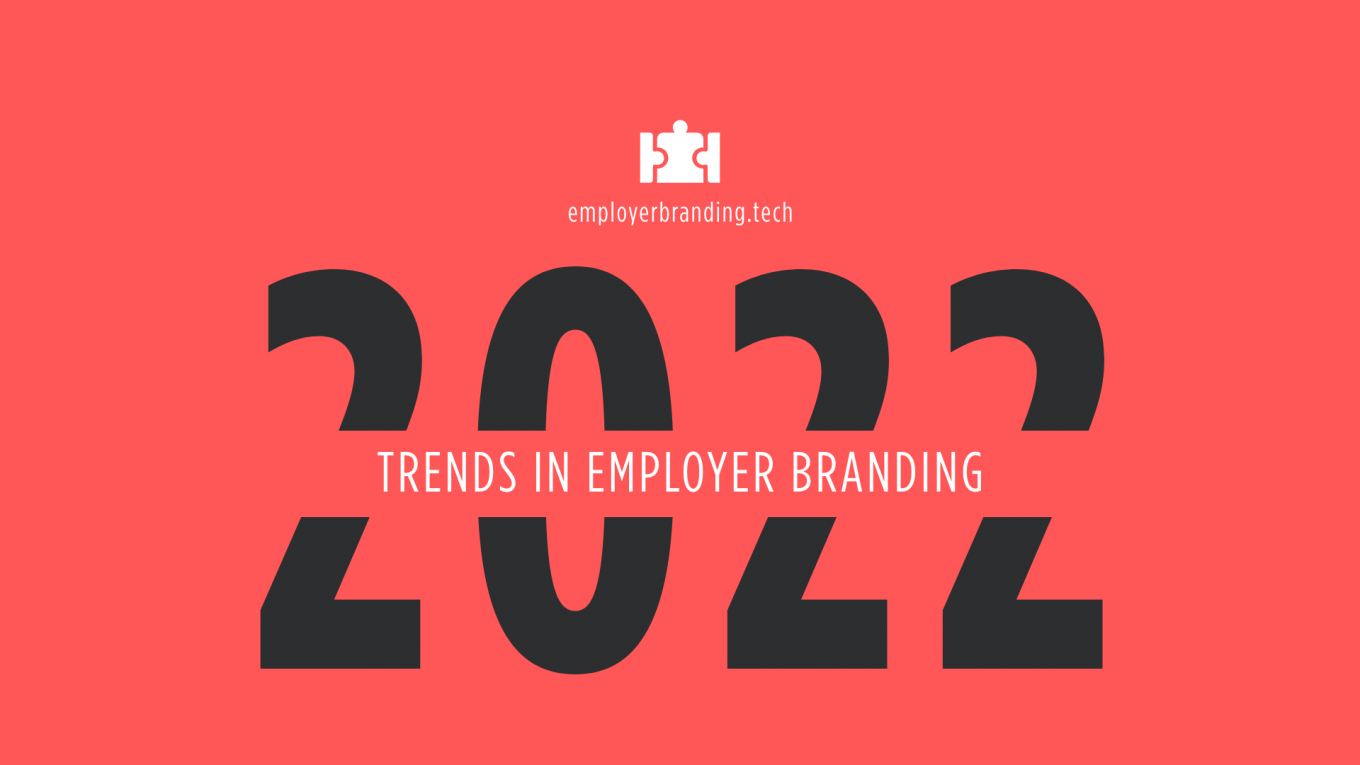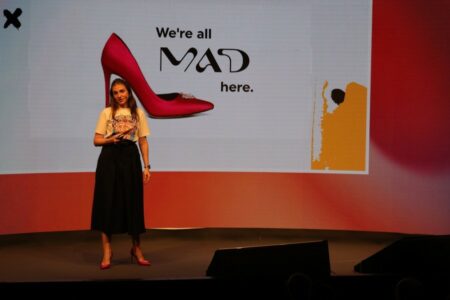Even before the pandemic, flexible ways of working and emerging technologies were visibly framing the way organizations and businesses at large hired and retained top talent. Covid-19 only accelerated the pace. Now more than ever, companies seek to onboard candidates with new skill sets, diverse talents, and broader perspectives. Increasingly more candidates seek to work with companies that are transparent, flexible, and authentic – three traits that go beyond money and other financial benefits.
A recent analysis on working trends done by LinkedIn highlights that several of today’s most wanted jobs can be performed remotely. The return to the office no longer exists and as the workplace dynamic changes, employees are no longer confined to the 9-to-5 work model. The new workplace is remote, flexible, and company culture-oriented. To become an employer of choice, it’s time for organizations to reflect on their employer branding initiatives.
As companies continue to pay more attention to digital transformation, it’s safe to say that digital skills are currently a top priority across major top industries and sectors.
“COVID-19 has escalated digital initiatives into digital imperatives. This has created urgent pressure on HR leaders to work with their CEO, CFO and CIO to rethink skills needed as business models change at light speed.” ( – Scott Engler, VP of Advisory at Gartner)
With certainty, nobody can predict what will happen in 2022 in employer branding. If 2021 was all about The Great Resignation, adjusting to working from home and hybrid work models, the new year will be about implementation, reframing EVPs, employee experience, diversion, combating burnout, and rethinking the work-life balance.
Let us have a closer look at some of the most notable trends in employer branding for 2022.
Remote work is the new work: transitioning from a presence culture to a culture of trust
The Great Resignation of 2021 happened because employees that could work from home refused to go back to the office. Google, for example, announced that its employees would return to the office as of Q1 of 2022. However, as the Great Resignation intensified across Europe and the US, the announcement was pushed back. In tech, for example, workers can now leverage a 2-year track record of WFH without any drops in productivity. Many will want to keep working remotely for various reasons, such as: save money on the commute, dedicate more time to their kids, and balance work and life with more ease.
In 2022, companies that become reluctant to WFH will have the most to lose. Labor Economist for ZipRecruiter, Julia Pollak, highlights that “the most reluctant to face the new reality are going to have to experience significant pain to catch up”. Already, jobs posted on ZipRecruiter with the “remote” mention get 300% more applicants than those without, according to the website’s recent research. In a global research study, McKinsey argued that over 50% of corporate and government workers would want to work from home 3 days per week following the pandemic. Almost a third of US workers wish to work from home permanently.
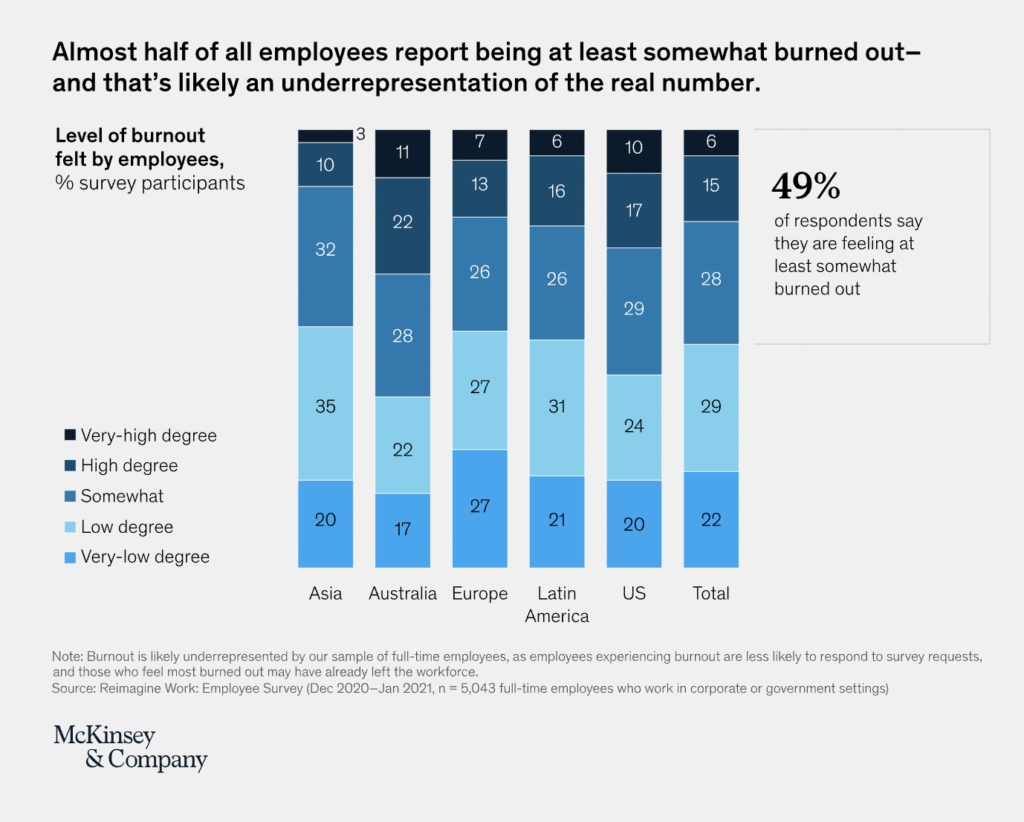
Although it’s here to stay, remote work will be equally challenging in 2022. Several of the most notable challenges will be maintaining employee engagement, retention, and morale. For decades, it has been proven that in-person collaboration keeps people active and motivated at work, meaning that company leaders will need to figure out new ways to preserve the connection. In a recent paper, Germany’s National Academy of Science and Engineering talks about the transitioning from “a presence culture to a culture of trust”. The design of the future workplace should be offering support. It should be flexible, interactive, and innovative, emphasizing on transparency and trust from companies to employees, and vice versa.
In the paper, Acatech advises organizations to replace static annual performance analyses with “continuous, transparent ad-hoc feedback, which takes account of peer feedback and is employee-driven rather than management-driven.” Since there’s no grand plan for shaping the future of work, the key is to set up experimental phases and test various strategies to see which ones resonate with the employees.
For Campusjäger, a German-based recruitment platform, the WFH concept was an opportunity to actively test distraction levels. The company participated in a field trial in which employees were wearing pulse-rate meters. The aim of the experiment was to analyze the level of stress caused by distractions from electronic devices. The results showed that disabling digital notifications for a certain amount of time enabled employees to stay focused 19% longer in the physical office, but even longer in a WFH scenario. Munich-based OroraTech, started using the Donut app that pairs co-workers and gives them a reminder to meet weekly, whether in-person or via Slack.
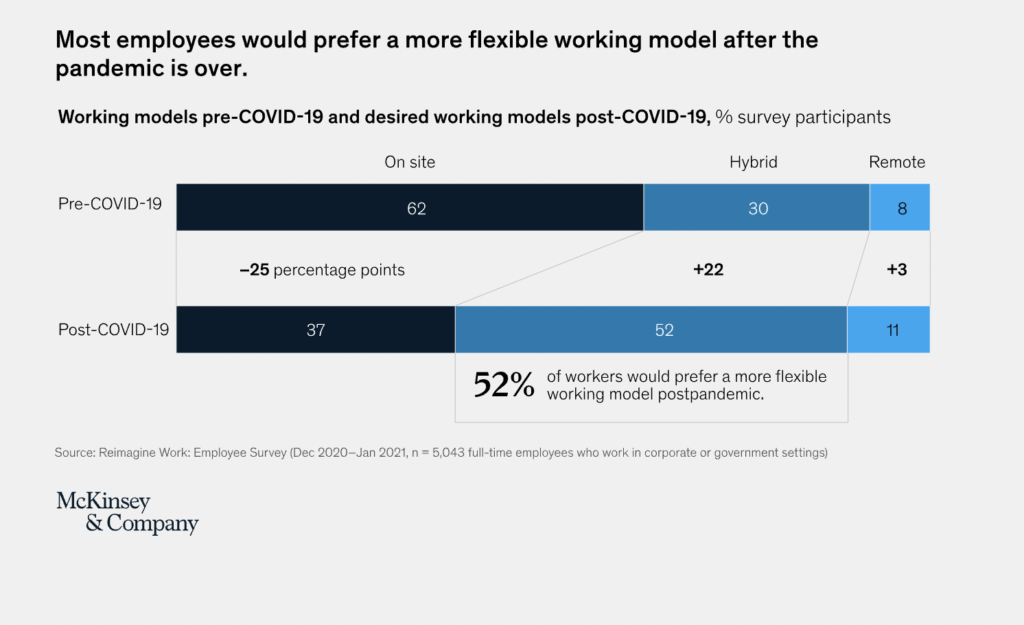
Action to take: Become more flexible!
Maintaining a strong company culture when working remotely can be challenging. In 2021, we’ve learned that employees can be productive in a WFH scenario. To preserve that productivity without compromising on employee engagement, the key is to become open to providing flexibility. Trust is earned and both companies and their employees have had nearly two years to prove that.
Diversity, equity + inclusion (DE&I)
As workers begin to realize what social values impact them, they will start looking for employers with similar values and social perspectives. Having a transparent, authentic DE&I policy in place is yet another trend in employer branding for 2022 because it goes beyond a feel-good initiative. Following an in-depth social listening analysis encompassing over 1,000 large companies in 15 countries, McKinsey’s Diversity Wins report shows that diversity doesn’t just increase profitability; it also helps companies hire and retain top talent.
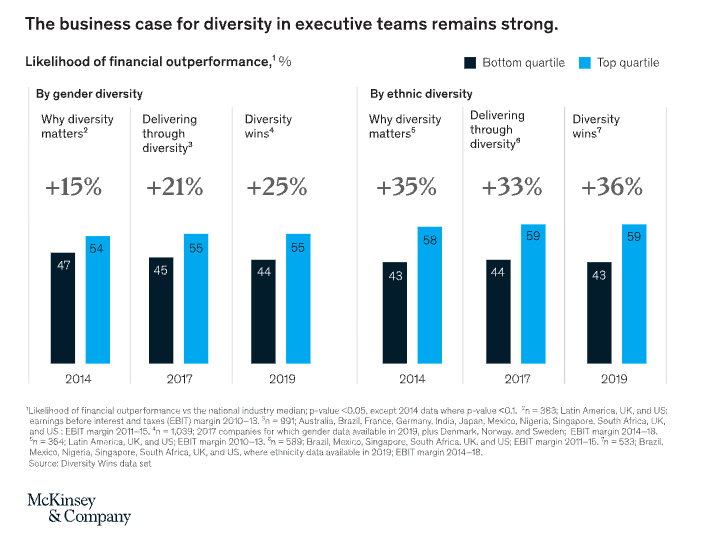
The results of the study showed that:
- Companies in the top-quartile for ethnic/cultural diversity on executive teams were 33% more likely to have industry-leading profitability.
- And companies in the top-quartile for gender diversity on executive teams were 21% more likely to outperform on profitability and 27% more likely to have superior value creation.
The drive to make DE&I a priority reflects in the booming demand for diversity and inclusion leadership and executive roles like “Head of Diversity & Inclusion”, “Chief Diversity Offices”, and “VP of Diversity & Inclusion”. Since June 2020, job listings in the D&I area have doubled, increasing 2.6 times, according to LinkedIn.
To make the most of diversity, companies will have to go beyond traditional concepts such as age, parenthood, or impairment. VP of editorial at SHRM, Tony Less, recommends “broadening the definition of what an effective successful candidate looks like”. For example, dropping education requirements like four-year degrees or X year of hands-on experience in a particular field could be a start in becoming more DE&I – focused in 2022.
Genetic information company, Invitae, has been strengthening its D&I efforts in 2020 by creating different activities, such as ERGs (employee resource groups). Over a period of 6 months, they’ve managed to foster allyship and community talks among employees with different programs and concepts such as “Women in Tech”, “Peer Soul Support” for mental wellness, “Veterans in Genetics”, and others. From employees’ perspective, the initiatives made work/life balance possible, reducing stress, and bringing out to the surface a great company culture.
Action to take: take D&I one step further with equity!
HR leaders should strive to make sure diversity is part of the entire organization, top management included. Furthermore, they must work to implement affirmative actions, enabling employees of all genders, colors, and creeds to thrive at work. To do that, diversity & inclusion (D&I) should be backed up by equity, and be presented as a comprehensive package.
In 2022, the aim is to promote access to opportunities and fair treatment for all, at the same time eliminating institutional barriers that might hinder a minority group’s potential. Also, it’s crucial for companies to understand the difference between equity and equality. Equity focuses on a culture of fairness targeted at the employee as a sole individual. Its aim is to make sure that the resources provided are customized so that the employee can grow and thrive at work.
Equality focuses on uniformity at a group level and eliminating systemic barriers. Its aim is to promote fairness across the entire organization by providing everyone access to the same resources. To become more DE&I – focused, follow the steps below:
- Diversify the interview and vetting process by setting up diverse hiring teams. This will not only impact the interviewing phase, but also onboarding. Candidates will feel more secure and comfortable, which increases the chances of accepting a job offer.
- Make sure your job descriptions are inclusive. Use language that is gender neutral and steer clear of confusing wording that might alienate applicants.
- Update the company EVP and Career Page. Make it diverse and inclusive with clear statements so that prospects can understand who you are, what your mission is, and how your values align with what you’ve achieved so far.
Employee wellness & burnout: it’s time to care about employee wellbeing!
Nearly two years of unpredictable, chronic stress triggered by the pandemic has made employees feeling less productive, unmotivated, unengaged, and unable to focus. In 2021, burnout has never felt more real. According to research done by UK-based health insurance company Lime Group, over 50% of employees “feel like they have to put on a brave face for their colleagues” and nearly 30% are actively struggling to stay productive as they feel employers are not supportive enough of their wellbeing. McKinsey’s mentions a similar percentage in a study that argues that 49% of respondents feel somewhat burned out.
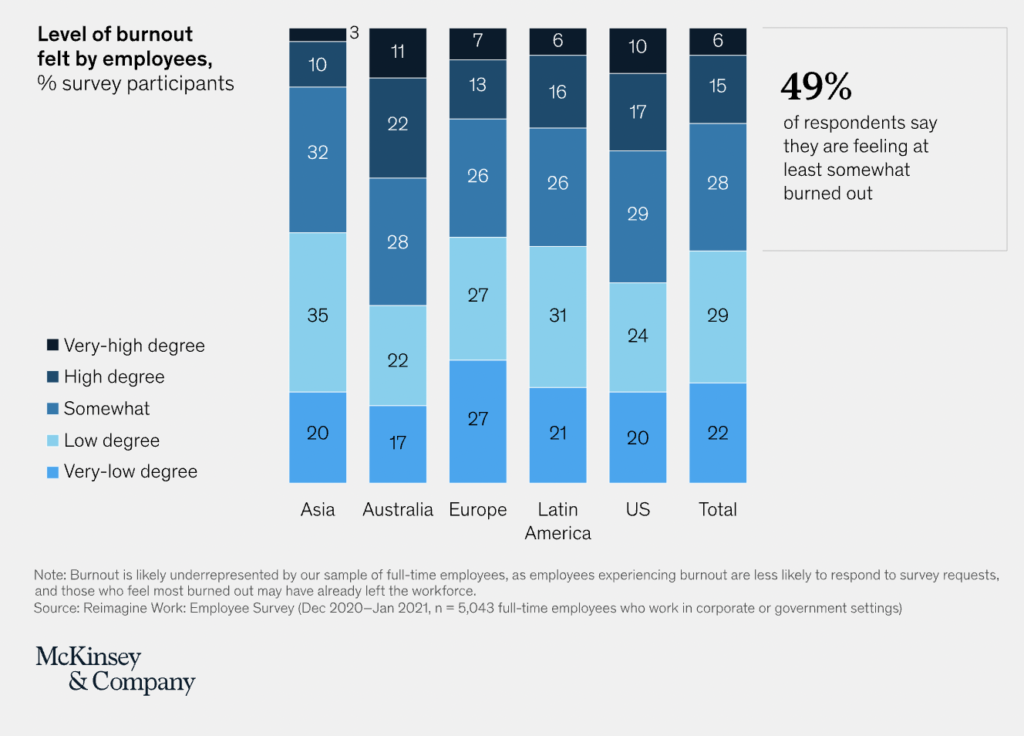
Even more, 40% would switch jobs if their employer doesn’t start to care more. In Germany, stress levels skyrocketed in 2021. Gallup mentions that 35% of German employees feel exhausted and those on Kurzarbeit would change jobs, as the furlough led them to lose trust in their employer. To help workers regain their focus and strengthen their motivation, 68% of global companies introduced one or more wellness benefits as of March 2020, according to Gartner.
And yet, even with the introduction of various health-related benefits, 41% of employees worldwide still considered leaving their current job, according to Microsoft. In July, 2021, there were over 1 million vacancies available in the UK, an all-time high. In Germany, over one third of the country’s companies reported a lack of competent workers.
2021 was an opportunity for organizations to open their eyes and acknowledge that caring about employees goes beyond implementing wellness programs. For any company looking to be more authentic and transparent in 2022, the key is to let your guard down and actively talk to people. C-suite executives and leaders must show more compassion and understanding. The more they interact with their people, the better chances they have to connect with them on a human level.
Action to take: rethink work-life balance!
There’s no one-size-fits-all solution to building a healthier company work culture. The key is to start with small initiatives, such as becoming more mindful about workload, more aware of the fact that WFH is not necessarily comfortable; at least, not for everyone. Now more than ever, employees need time off, meaning that rather than get stuck in the “work-life balance” concept, companies should transition to “work-life integration”.
Before the pandemic, “work-life balance” was about learning to differentiate between what happens at work and what happens at home. But now that the office is at home, “balance” has been replaced with “integration”; a new approach that aims to build synergies between family, health, work, wellbeing, community, etc.
How can “work-life integration” help HR managers and companies at large increase retention, reduce absenteeism, combat employee burnout, and boost productivity? Once again, there’s no universal approach because it all depends on a company’s core values and its willingness to adapt to the needs of its employees. For 2022, the recommendations below might help, though:
- Less focus on input, more focus on output: rather than put pressure on employees and monitor the number of hours worked, maybe focus more on tasks completed and deadlines met. Working 40 hours a week doesn’t necessarily translate to high productivity.
- Flexibility 2.0: give your employees more freedom to manage their work schedule, but go beyond flexible working hours.
- Work-life integration awareness programs: HR managers and leaders should help employees work through the challenges of working remotely.
All eyes on employee experience: purpose, values, belonging!
Employee experience is an overall concept that includes all the activities happening within an organization; activities that make an impact or create a feeling within its employees. In simple terms, employee experience drives the perception of any company’s employer brand. 2021 was an opportunity to dwell upon the question: “How does my company stand out?”, “Why are my people leaving?” and “What can I do to prevent them from leaving?”
The “how, why, what” are all linked to employee experience. Because experience includes interactions across the entire employee lifecycle – from candidate status to exit, and it includes all facets of work life. Since the pandemic started, expectations at work have changed and increasingly more employees want to see their employer deliver on their promises.
In 2022, leadership buy-in will play a crucial role in creating memorable employee experiences. Recent research shows that engagement levels are linked to the way leadership perceives engagement, and engagement is linked to both purpose and belonging.
After surveying over 11,800 full-time employees from 20 countries, Qualtrics found that confidence in senior leadership and L&D opportunities were the two main drivers of having a sense of belonging. Belonging is highly correlated to engagement. 20% of employees who feel they don’t belong are engaged, vs. 91% of those who feel they do – that’s 3.5x more.
Moving forward, organizations that want to provide exceptional employee experiences in 2022 should:
- Create a shared sense of purpose
- Strengthen their company values via transparency, honesty, and trust
- Use leadership buy-in to increase employee engagement and attract genuine candidates (who will stay long-term because they feel connected – they feel that they belong!)
Action to take: leverage leadership buy-in to increase engagement!
Employer branding goes beyond recruitment marketing, convincing more employers to consider all aspects of the employee experience to attract and retain top talent. In 2021, companies have learned that a successful employer branding strategy is customized and tailored to the specific needs of every candidate and employee across different regions and departments.
For customization to happen, get closer to your employees with leadership buy-in. Walk the talk by showing them that, as a leader, you:
- Are committed to making your company a great place to work
- Value your employees and acknowledge that they’re the most important resource you have
- Buy into your company’s engagement strategy to inspire and instill trust
- Set the right pace and identify problems that you can solve with an employee engagement program
- Connect engagement programs to business goals and objectives
According to Gartner’s 2020 ReimagineHR Employee Survey, building deeper relationships with employees leads to a 23% increase in the number of people reporting better mental health and a 17% increase in those reporting better physical health. Employers that support their employees more holistically realize a 21% increase in high performers.
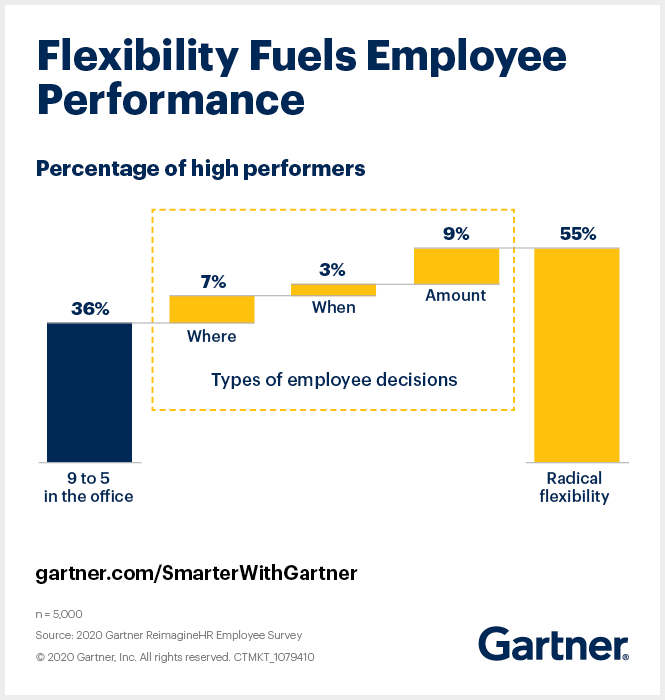
Leaving numbers and statistics aside …
The events of 2021 have overturned organizational strategies in both recruitment and employer branding. As mentioned in the beginning of this article, remote work is the NEW work and transitioning to a culture of presence to a culture of trust could be the key to combating last year’s great resignation manifesto. Flexibility, DE&I – focused strategies, employee wellbeing, work-life integration, employee experience, and leadership buy-in are just some of the most notable trends in employer branding for 2022. We can’t really know what will happen in the next 12 months, but considering everything that’s happened last year, it’s safe to say that employer branding has played a pivotal role in shaping company cultures worldwide.
Although intangible, an employer brand comes with tangible practices that help build a solid foundation for any organizational culture. It takes time and resources to become an employer of choice, and the sooner you realize that it’s an on-going process the better chances you have to see long-term results.



